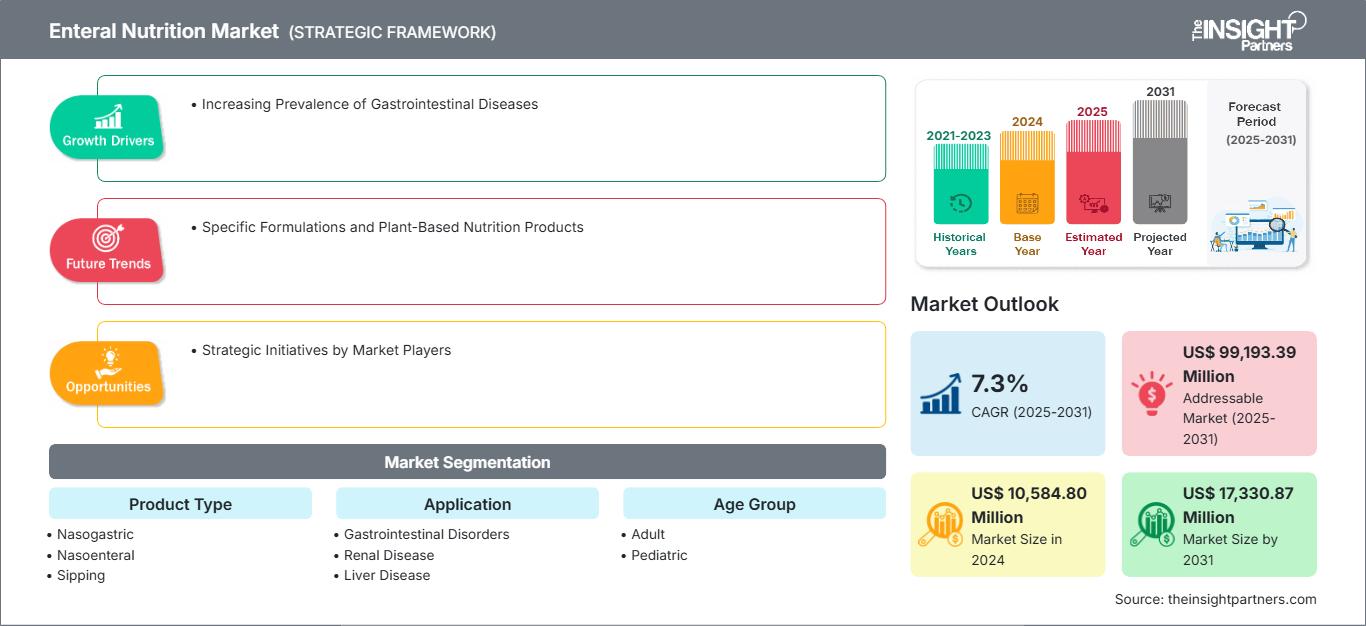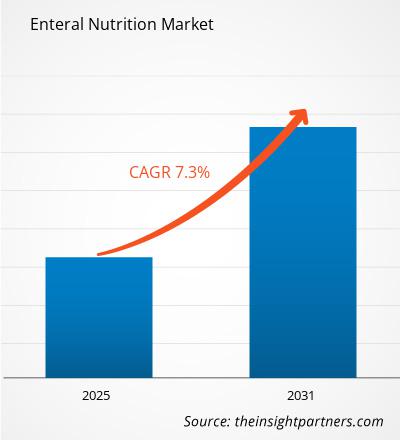肠内营养市场规模预计将从 2024 年的 105.848 亿美元增至 2031 年的 173.3087 亿美元。预计该市场在 2025 年至 2031 年期间的复合年增长率为 7.3%。特定配方和植物性营养产品可能会在预测期内带来新的市场趋势。
肠内营养市场分析
胃肠道疾病包括克罗恩病、肠梗阻、溃疡性结肠炎、短肠综合征、显微镜下结肠炎和某些癌症类型。这些疾病通常由于肠道炎症、损伤或功能障碍而导致营养吸收不良。根据《罗马基金会全球研究结果:功能性胃肠道疾病的全球患病率和负担》, 2021年1月发表的一项研究表明,功能性胃肠疾病已影响全球超过40%的人口。此外,克罗恩病是一种主要影响消化系统的复杂慢性疾病,是北美和欧洲最常见的疾病。英国克罗恩病和溃疡性结肠炎协会的一项研究表明,2022年,英国每123人中约有1人患有克罗恩病或溃疡性结肠炎,这意味着英国有近50万人患有炎症性肠病(IBD)。
根据2023年发表的《应对欧洲消化系统疾病负担》研究,估计欧洲国家有超过3.32亿人患有消化系统疾病。非营利组织英国肠道协会(Guts UK)的数据显示,影响肠道、肝脏和胰腺的消化系统疾病导致英国八分之一的死亡。同样,每年每百万人中约有 3 人患有短肠综合征 (SBS)。根据2020年发表的题为《理解短肠综合征:现状与未来展望》的文章,SBS的患病率在过去40年中飙升了两倍多。在美国,SBS的患病率约为每1000万人300例,在欧洲,约为每1000万人14例。患有胃肠道疾病的患者营养不良的风险较高,因为他们在接受诊断检查前被要求禁食。他们还可能由于治疗性饮食限制以及厌食症或营养需求改变引起的食欲不振而面临营养不良,而厌食症或营养需求改变可能是疾病本身的结果。因此,患有慢性疾病或正在接受慢性疾病治疗的患者可能需要肠内营养来满足其日常营养需求。
肠内营养市场概览
由于癌症、糖尿病等慢性疾病、神经系统疾病和胃肠道疾病发病率的上升,肠内营养市场正在迅速扩张;人口老龄化;营养不良患病率的上升;以及肠内营养产品的进步,例如创新型喂食管、喂食泵和配方。市场上的知名企业正致力于创新与合作,以提高产品的可用性。然而,肠内营养产品的高成本可能会阻碍市场的增长。
自定义此报告以满足您的要求
您将免费获得任何报告的定制,包括本报告的部分内容,或国家级分析、Excel 数据包,以及为初创企业和大学提供超值优惠和折扣
肠内营养市场: 战略洞察

-
获取本报告的主要市场趋势。这个免费样本将包括数据分析,从市场趋势到估计和预测。
肠内营养市场驱动因素和机遇
营养不良和早产病例增加导致对肠内营养的需求增加
营养不良包括营养不足、超重或肥胖、维生素或矿物质缺乏以及不良饮食相关的非传染性疾病。根据世界卫生组织 (WHO) 的数据,2021 年全球约有 19 亿成年人超重或肥胖,而体重不足的人数为 4.62 亿。此外,5 岁以下儿童超重 3900 万,由于长期无法获得营养食品而生长发育缓慢,4500 万消瘦(身高偏瘦)。5 岁以下儿童死亡人数中约有 45% 与营养不良有关。此外,欧洲临床营养与代谢学会 (ESPEN) 和世界卫生组织于 2024 年 9 月在意大利米兰联合举办了第 46 届 ESPEN 大会。大会报告称,营养不良影响着欧洲 30% 至 50% 的住院患者、40% 的肿瘤患者、30% 至 70% 的老年人、24% 的住院心血管或肺部疾病患者以及 38% 至 78% 的重症监护病房患者。
根据联合国国际儿童紧急基金会 (UNICEF) 2022 年 7 月的数据,营养不良的发生率从 2019 年的 8.0% 上升到 2020 年的 9.3%;2021 年进一步跃升至 9.8%。根据《医院营养不良多中心调查》, 2021年发表的一项研究表明,美国约有33%的住院患者营养不良或面临营养不良风险,而英国近11%至45%的住院和家庭护理机构患者营养不良。营养支持可根据需要通过肠内途径提供,这是治疗大多数营养不良病例的重要且合适的方法。因此,儿童和成人营养不良的巨大负担推动了对肠内营养配方和产品的需求。
市场参与者为创造市场利润机会而采取的战略举措
肠内营养市场中的公司持续关注战略发展,例如合作、扩张、协议、伙伴关系和创新产品配方。这些战略帮助他们提高销售额,扩大地理覆盖范围,并增强其服务于更大客户群的能力。肠内营养市场的一些值得关注的发展如下。
- 2024年5月,达能完成了对美国领先的全食品管饲企业FunctionalFormularies的收购。通过此次收购,达能计划进一步扩大其肠内管饲产品系列,从而增强其在美国的医疗营养产品组合。
- 2023年1月,纽迪希亚推出了Fortimel PlantBased Energy,这是其首款植物基即饮口服营养补充剂。该产品专为满足营养不良人群或因疾病而面临营养不良风险的人群的营养需求而配制。Fortimel推出后,该公司计划依托达能(母公司)在植物营养方面的专业知识,扩展其Fortimel产品组合。纽迪希亚 (Nutricia) 已在荷兰、丹麦、挪威、西班牙、芬兰和捷克共和国推出这款新产品。
因此,创新型即饮或即用营养补充剂的推出、针对各种健康问题的创新产品开发以及扩张和收购等战略举措,使肠内营养市场中的公司能够创造新的或改进的产品和新业务,从而保持市场竞争力。因此,此类战略增长计划为市场创造了巨大的增长机会。
肠内营养市场报告细分分析
促成肠内营养市场分析的关键细分包括类型、应用和最终用户。
- 根据产品类型,肠内营养市场分为鼻胃管、鼻肠管、啜饮和其他。 2024 年,鼻胃管细分市场占据最大市场份额。
- 根据应用,肠内营养市场细分为胃肠道疾病、肾病、肝病、肿瘤学、神经病学等。2024 年,胃肠道疾病细分市场占据最大市场份额。
- 按年龄组划分,肠内营养市场分为成人和儿童。2024 年,成人细分市场占据更大市场份额。
- 根据分销渠道,肠内营养市场细分为医院药房、零售店和电子商务。2024 年,医院药房细分市场占据最大市场份额。
按地区划分的肠内营养市场份额分析
肠内营养市场报告的地理范围主要集中在五个地区:北美、亚太地区、欧洲、南美和中美以及中东和非洲。就收入而言,北美在 2024 年占据市场主导地位。预计在预测期内,北美将继续在全球市场占据主导地位。美国是全球最大的肠内营养产品市场。美国市场的增长可能与医疗营养产品需求的蓬勃发展有关,尤其是在老龄化人口和慢性病患者中。此外,肥胖和糖尿病患病率的上升导致需要肠内营养的患者数量激增,因为这些疾病可能导致并发症,影响正常的喂养和消化。根据国际糖尿病联合会 (IDF) 2021 年第 10 版《糖尿病图谱》,2021 年美国确诊患有糖尿病的人数为 32,215 人,预计到 2045 年将上升到 36,289 人。
肠内营养
肠内营养市场区域洞察
The Insight Partners 的分析师已详尽阐述了预测期内影响肠内营养市场的区域趋势和因素。本节还讨论了北美、欧洲、亚太地区、中东和非洲以及南美和中美洲的肠内营养市场细分和地域分布。
肠内营养市场报告范围
| 报告属性 | 细节 |
|---|---|
| 市场规模 2024 | US$ 10,584.80 Million |
| 市场规模 2031 | US$ 17,330.87 Million |
| 全球复合年增长率 (2025 - 2031) | 7.3% |
| 历史数据 | 2021-2023 |
| 预测期 | 2025-2031 |
| 涵盖的领域 |
By 产品类型
|
| 覆盖地区和国家 |
北美
|
| 市场领导者和主要公司简介 |
|
肠内营养市场参与者密度:了解其对业务动态的影响
肠内营养市场正在快速增长,这得益于终端用户需求的不断增长,而这些需求的驱动因素包括消费者偏好的演变、技术进步以及对产品益处的认知度的提升。随着需求的增长,企业正在扩展产品线,不断创新以满足消费者需求,并抓住新兴趋势,从而进一步推动市场增长。

- 获取 肠内营养市场 主要参与者概述
肠内营养市场新闻及最新发展
肠内营养市场评估通过收集一手和二手研究的定性和定量数据进行,这些数据包括重要的企业出版物、协会数据和数据库。以下是肠内营养市场的一些关键发展:
- Arla Foods Ingredients 推出了一种新型乳清蛋白水解物,其口感优于同类肽基医学营养成分。高度水解的乳清蛋白成分 Lacprodan DI-3092 可将 10 克优质单一来源蛋白质填充至 100 毫升液体中。这一数字远高于每 100 毫升 6-7 克的市场标准。此外,它口感极佳,苦味极少,有助于克服医学营养领域的一项关键挑战。 (Arla Foods,2024 年 11 月)Kate Farms 推出首款儿科混合膳食创新产品,将首款以植物基、有机、全食物混合膳食为特色的便捷产品带入市场。Kate Farms 儿科混合膳食专为 1 至 13 岁儿童设计,旨在帮助他们健康成长发育,这些产品可用于管饲和口服喂养。该产品提供三种口味,提供丰富的食材选择,满足典型的一日三餐需求,并采用创新的可重复密封单份包装袋,可更快速、更轻松地连接到常见的管饲装置。 (来源:Kate Farms,新闻稿,2024 年 1 月)
肠内营养市场报告覆盖范围和可交付成果
《肠内营养市场规模和预测(2021-2031)》报告对市场进行了详细的分析,涵盖以下领域:
- 肠内营养市场规模以及涵盖范围内所有主要细分市场的全球、区域和国家/地区层面的预测
- 肠内营养市场趋势以及市场动态,例如驱动因素、限制因素和关键机遇
- 详细的 PEST 和 SWOT 分析
- 肠内营养市场分析,涵盖主要市场趋势、全球和区域框架、主要参与者、法规和最新市场发展
- 行业格局和竞争分析,涵盖市场集中度、热图分析、知名参与者和肠内营养市场的最新发展
- 详细的公司简介
- 历史分析(2 年)、基准年、预测(7 年)及复合年增长率
- PEST和SWOT分析
- 市场规模、价值/数量 - 全球、区域、国家
- 行业和竞争格局
- Excel 数据集
近期报告
客户评价
购买理由
- 明智的决策
- 了解市场动态
- 竞争分析
- 客户洞察
- 市场预测
- 风险规避
- 战略规划
- 投资论证
- 识别新兴市场
- 优化营销策略
- 提升运营效率
- 顺应监管趋势






















 获取免费样品 - 肠内营养市场
获取免费样品 - 肠内营养市场